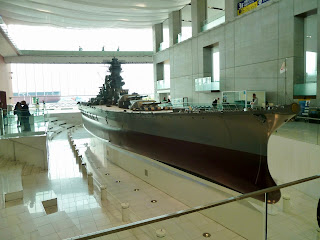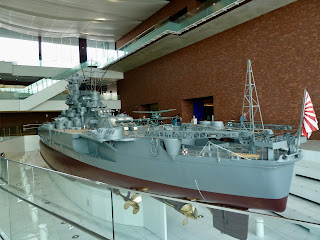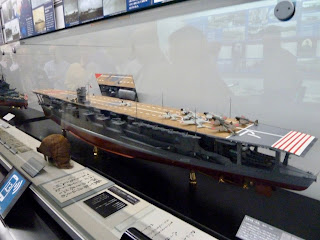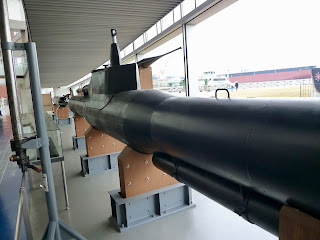22nd- 23rd Oct 2019
Right: It even had a biplane 'spotter' aircraft on the rear deck. I couldn't work out how it took off, let alone landed (presumably ditched if out of range of land).
Left: It had the most amazing amount of smaller gun turrets amidships.
Right: An example (presumably replica) of a 46cm naval gun.

Right: A description of these suicide torpedoes. Click on to enlarge to read.

Left: A Zero fighter is on display. A very capable machine in its day.

Right: A Type D 'Koryu' midget-submarine. Many were built at Kure during WW2.

Left: Adjacent to the museum is a decommissioned (in 2004) submarine, the Akishio (nicknamed 'The Whale of Iron') It is 76m long. This is open to the public (free entry) and provides, according to the brochure, a fascinating tour of all the compartments and living accommodation. I was really looking forward to seeing around inside. Unfortunately, for some reason I didn't establish, it was bleedin' well closed that day. Very disappointing.
Left: .....as are the Underground personnel. They are also very helpful to bemused tourists.
Off that afternoon to Tokyo.........
 |
| Neptune statue outside the Kure 'Yamato' Maritime Museum. |
I got to hear, belatedly, of an interesting sounding Naval museum in the port of Kure, about 40 miles south of Hiroshima. I took the 10.20am train from Nagasaki and had to change at Shin Tosu for Hiroshima and then on to Kure. I hoped to arrive there at about 2.00pm for a visit and stay the night in Kure. It all went a bit wrong! For the first time in ages (I remember once going to Newcastle and waking up in Edinburgh) I fell asleep on the train and woke up as the train was stationary in Shin Tosu. You only have about 60 seconds to get off at these intermediate stops and I didn't make it! Next stop was Tosu itself so I decided to get off there and wait for the next train. At this stop (about 10 minutes later) my suitcase got stuck in the luggage rack and despite much frantic tugging the train moved off again! I thought I was doomed to a big diversion. Fortunately a very helpful lady conductor saw my desperate struggle and suggested I go on to the next stop, Hakata, and there would be a fast train from there to Hiroshima arriving at 3.15pm. So I did. I then thought it would be too much of a rush to get to Kure and anyway I couldn't find a cheap hotel there. So I decided to spend the night in Hiroshima and go to the museum the following morning. It turned out to be a very fortunate move. Another night in Hiroshima in another great little (cheap) hotel near the station was a pleasant break with a jolly evening spent downtown. On arrival at Kure the next morning (Wednesday) I was told it had been closed yesterday (Tuesday) because Monday, when it is usually closed, was a public holiday and open then but closed the next day instead! What a fortunate fluke. FYI, as I discovered, many museums in Japan are closed on Mondays (unless public holidays). Confusing.
Kure had been a major Japanese naval base and arsenal since 1889 until the end of WW2
This museum is centred around the WW2 Japanese battleship Yamato. The blurb said it was the biggest battleship ever built at 263m long. I think this is wrong as the USS Iowa was 270m long. Maybe it was heavier?
Left: A 1:10 scale model of the ship in the central hall. The main guns, 9 of them in three turrets, were 46cm calibre (18.1 inch).
Right: It even had a biplane 'spotter' aircraft on the rear deck. I couldn't work out how it took off, let alone landed (presumably ditched if out of range of land).
Left: It had the most amazing amount of smaller gun turrets amidships.
Anyway it was sunk in April 1945 by US fighter-bombers when on its way to Okinawa. As indeed at some point was most of the rest of the Japanese fleet, and the remainder scuttled.
The wreck, which was only discovered in 2016, is widely scatterd in bits over the sea-bed. It had blown up. It had had a ship's complement of 3332 of which 3056 perished. An underwater video showed the wreckage.
Right: An example (presumably replica) of a 46cm naval gun.
Left: A diorama of one of the 12 boilers used to power the Yamato. This type of boiler was rescued from some Japanese ships (before they were scuttled) and used ashore and, I believe, some are still operational.
There are many more exhibits of Japanese naval vessels, plans and technology including this (right) of a pre-WW2 Imperial Japanese Navy aircraft carrier, the Akagi. There were lots of details of the exhibits but unfortunately most of the descriptions were in Japanese.
Left: This was interesting. It is a Kaiten human ridden 'kamikaze' torpedo. About a hundered of these were actually used. Understandably there are not many left. I don't suppose the Kaiten Veterans Association ever had many members.

Right: A description of these suicide torpedoes. Click on to enlarge to read.

Left: A Zero fighter is on display. A very capable machine in its day.

Right: A Type D 'Koryu' midget-submarine. Many were built at Kure during WW2.

Left: Adjacent to the museum is a decommissioned (in 2004) submarine, the Akishio (nicknamed 'The Whale of Iron') It is 76m long. This is open to the public (free entry) and provides, according to the brochure, a fascinating tour of all the compartments and living accommodation. I was really looking forward to seeing around inside. Unfortunately, for some reason I didn't establish, it was bleedin' well closed that day. Very disappointing.
Off that afternoon to Tokyo.........









No comments:
Post a Comment